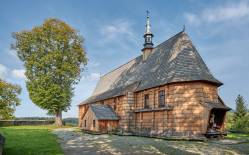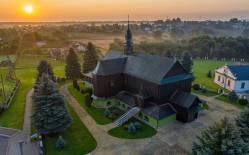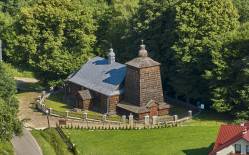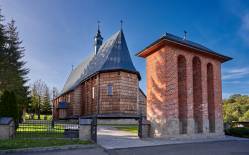Jaćmierz is the most valuable architectural jewel of the western part of the Sanok District. Its most notable landmarks include the unique church of the Assumption of the Blessed Virgin Mary, a rare example of a wooden structure imitating the Baroque-style twin-tower brick churches. It was founded in the 1640s by Regina Balowa, and consecrated in 1644. Following a fire, in the 18th century the towers were added along with the porch, and the building was divided into three naves. In the 1800s, two side chapels were added creating a transept.
The rood beam is decorated with late Baroque sculptures. Spectacular ornamental and figural wall paintings embellish the magnificent interior. The Baroque and Rococo style furnishings mainly date from the 1700s. The high altar holds a 17th century painting of the Holy Mother and Child. On the chapel wall we can see The Baptism of the Lord, a painting in Gothic and Renaissance style dated to the first half of the 1500s. Its upper frame is embellished with a relief, from the late 14th/early 15th century, depicting John the Baptist’s head.
The wall around the church adjoins a building of an old hospital and shelter for poor people.
This is not the only church in Jaćmierz. At the outskirts of the village, in Posada Jaćmierska we can see a wooden Polish Catholic church of the Most Sacred Heart of Jesus. This is one of the two oldest Polish Catholic churches in the country (the other one is located in the nearby village of Bażanówka). The atmosphere of an old Galician town is evoked by the main square in Jaćmierz; it features a complex of the 19th century wooden buildings typical for small towns; the single-story houses of townspeople once living in Jaćmierz stand in a row, with their gable ends pointing towards the square. Its size bears witness to the former times of prosperity of this place which had acquired municipal rights in 1390, but unfortunately lost them during the interwar period.
Photo: Krystian Kłysewicz
Gallery
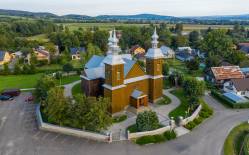
Recommended venues on the Trail



This website has been modernized with the financial support of the European Union under the Cross-Border Cooperation Programme Poland-Belarus-Ukraine 2014-2020. The responsibility for its content lies solely with the Podkarpackie Regional Tourism Board and cannot, in any case, be treated as a reflection of the position of the European Union, the Managing Authority, or the Joint Technical Secretariat of the Cross-Border Cooperation Programme Poland-Belarus-Ukraine 2014-2020.










